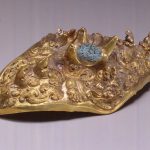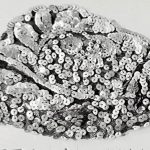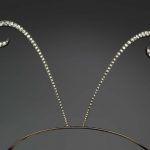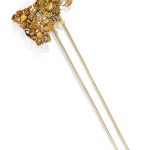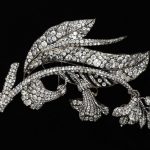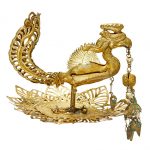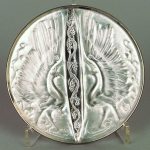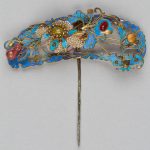Hair ornaments have been used to decorate the hair for centuries. Below are some examples of antique and vintage hair ornaments including one by Lalique and a rare ornament in the form of a phoenix.
Hair Ornament 8th–early 10th century Indonesia (Java)
Reference: The Metropolitan Museum of Art
womens hair and hat ornament, evening wear. 20th century. Sequin-decorated hair and hat ornament.
Reference: Museum of Applied Art and Sciences
Hair ornament with antennae René Lalique (French, 1860–1945) French about 1900
his hair ornament with its whimsical character is a unique piece by Lalique. It features the unusual exclusive use of diamonds which were sparingly used by the Art Nouveau jewelers who preferred less precious stones and enamel to provide color and opalescence. From the gold wire headband emerge two antenna composed of hollow silver cubes in which are set graduated brilliants each secured by four prongs. A steel wire runs through the cubes to form the curved shape of each antenna. Except for the scroll terminals of the antennae, each cube is individually mounted and stacked without being attached to each other so that they tremble when the wearer moves, accentuating the sparkle of the diamonds.
Reference: Museum of Fine Arts Boston
A GOLD ‘PRUNUS’ HAIR ORNAMENT QING DYNASTY, 18TH – 19TH CENTURY the soldered thin twisted gold wires branching off into a spray with four fine filigree prunus flowers with upright naturalistic stamens and filigree teardrop leaves
Sold for 5,625 HKD at Sotheby’s in 2019
Part of hair ornament, brilliant-cut diamonds open-set in silver, backed with gold ca. 1820 (made).
The hair ornament is made of a spray of leaves and fuchsias.
A love of nature was one of the most universal and respected sentiments in the 19th century. Naturalistic jewellery, influenced by the Romantic movement and the revived Rococo style, developed early in the period. Its success was due to the beauty and wearability of jewelled flowers and foliage, but also to the continuing interest in botany.
Until around 1830 the designs were stylised and delicate. Later, the ever-more precise copies of flowers, leaves, fruit and insects formed extravagant, colourful and complex compositions. Often the ornament included roses, lilies, chrysanthemums and fuchsias, the most fashionable flowers at the time.
Reference: © Victoria and Albert Museum
A rare gilt silver head ornament in the form of a phoenix 9th-11th century The finely modeled crested bird with chased hollow body set off by a high crested tail and separately fashioned openwork wings attached through the body and pierced with two small holes at each tip suspending pendant chains, a further cluster of ornaments and chains falling from the slender beak, the small legs inserted through a bed of delicately fashioned layers of lotus petals. 3in (7.6cm) high
Sold for US$ 27,575 (£ 20,995) inc. premium at Bonham’s in 2019
